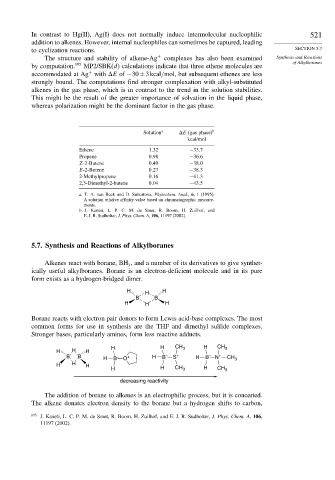Page 540 - Advanced Organic Chemistry Part A - Structure and Mechanisms, 5th ed (2007) - Carey _ Sundberg
P. 540
In contrast to Hg(II), Ag(I) does not normally induce intermolecular nucleophilic 521
addition to alkenes. However, internal nucleophiles can sometimes be captured, leading
to cyclization reactions. SECTION 5.7
The structure and stability of alkene-Ag + complexes has also been examined Synthesis and Reactions
of Alkylboranes
by computation. 195 MP2/SBK(d calculations indicate that three ethene molecules are
+
accommodated at Ag with E of −30±3kcal/mol, but subsequent ethenes are less
strongly bound. The computations find stronger complexation with alkyl-substituted
alkenes in the gas phase, which is in contrast to the trend in the solution stabilities.
This might be the result of the greater importance of solvation in the liquid phase,
whereas polarization might be the dominant factor in the gas phase.
Solution a E (gas phase) b
kcal/mol
Ethene 1 32 −33 7
Propene 0 98 −36 6
Z-2-Butene 0 49 −38 0
E-2-Butene 0 27 −38 3
2-Methylpropene 0 16 −41 3
2,3-Dimethyl-2-butene 0 04 −43 5
a. T. A. van Beek and D. Suburtova, Phytochem. Anal., 6, 1 (1995).
A solution relative affinity value based on chromatographic measure-
ments.
b. J. Kaneti, L. P. C. M. de Smet, R. Boom, H. Zuilhof, and
E. J. R. Sudholter, J. Phys. Chem. A, 106, 11197 (2002).
5.7. Synthesis and Reactions of Alkylboranes
Alkenes react with borane, BH , and a number of its derivatives to give synthet-
3
ically useful alkylboranes. Borane is an electron-deficient molecule and in its pure
form exists as a hydrogen-bridged dimer.
H H H
B B
H H H
Borane reacts with electron pair donors to form Lewis acid-base complexes. The most
common forms for use in synthesis are the THF and dimethyl sulfide complexes.
Stronger bases, particularly amines, form less reactive adducts.
H H H H H CH 3 H CH 3
B B H B – O + H B – S + H B – N + CH 3
H H H
H H CH 3 H CH 3
decreasing reactivity
The addition of borane to alkenes is an electrophilic process, but it is concerted.
The alkene donates electron density to the borane but a hydrogen shifts to carbon,
195
J. Kaneti, L. C. P. M. de Smet, R. Boom, H. Zuilhof, and E. J. R. Sudholter, J. Phys. Chem. A, 106,
11197 (2002).

